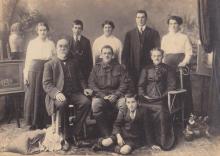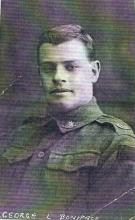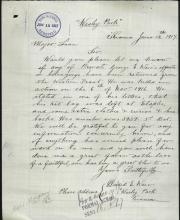George Ernest Weir
Born 21 November 1894 in Kiama, NSW, George Ernest Weir grew up at Wesley Park (in Kiama Heights), ‘between the hills and the sea’. The farm was very close to ‘Bush Bank’, the childhood home of his mother, and a short ride from ‘Buena Vista’ in Gerringong, the home of his father.
A keen rifle-shooter, George enlisted in August 1915 and embarked on 30 Dec.1915.
George was a popular young man, an active church-goer (at Christ Church Kiama) and Sunday School teacher. Before leaving he was farewelled numerous times, from the Church itself, from the Anglican Men’s Society, the Girl’s Friendly Society, the sporting groups he belonged to, and so on.
He arrived in France in April 1916 (having travelled via Egypt), and joined his company on the Western Front. To his distress he was separated at this point from his boyhood friend (also called George) who had enlisted at the same time, and he tried very hard to be transferred to his ‘brother’s’ company. It is not clear if this happened – in his letters home he asks constantly for news of George (Boniface).
George’s first serious engagement in the horror that was trench warfare was at Pozières, which took place 22-28 July 1916. Wounded in the jaw, he wrote home to his family saying (cheerfully) ‘If my jaw had been a bit worse I would have got a trip to England with it!’ He qualified this by expressing, more soberly, his concerns about his mates, particularly his ‘brother’ George, and saying ‘I knew such a lot of real good fellows who have gone under...To tell you the truth I was glad to get out of it for a while’. As it was, George was deemed sufficiently recovered to rejoin his unit in mid September 1916.
George as killed in action on the Somme as the line pushed past Flers on 6 November 1916. According to the unit diary, it was bitterly cold, with gale force winds and constant rain. In fact, further action was temporarily halted after 6 November due to the weather.
George has no known grave, but he is commemorated on the wall of the memorial at Villers-Bretonneux as follows: Pte GE Weir, 3rd Battalion AIF, Service Number 3939. He was just a few weeks short of his 22nd birthday.
George’s parents ee visiting family near Lismore when the telegram arrived advising that George had been killed. The message was delivered in early December 1916 by the local Anglican minister, and caused enormous grief to all in the family, and to the wider community. Isabella never quite recovered – her obituary (in 1923) described her heartbreak at the loss of her boy, and letters between George’s father and the War Office (seeking further information and also return of George’s personal effects) also stressed their continuing sorrow.
George was one of nine children. Three died in childhood, another served in Palestine but was spared to come home. After the war two of the brothers married, as did one of the three remaining sisters. (There was a shortage of eligible men to marry, so noticeable it was frequently commented upon by the local papers.) None of the siblings had children.
Links
-
First World War Embarkation Rolls - George Ernest Weir
- http://www.awm.gov.au/people/rolls/R1807535/
-
Roll of Honour - George Ernest Weir
- https://www.awm.gov.au/people/rolls/R1669626/
-
Australian War Graves
- http://www.australianwargraves.org/www/592/1001127/displayarticle/1005258.htm...
-
Mapping our ANZACS
- http://mappingouranzacs.naa.gov.au/list-birth.aspx?birth=Kiama%2c+NSW%2c+Aust...
-
The AIF Project
- http://www.aif.adfa.edu.au:8080/showPerson?pid=318032



